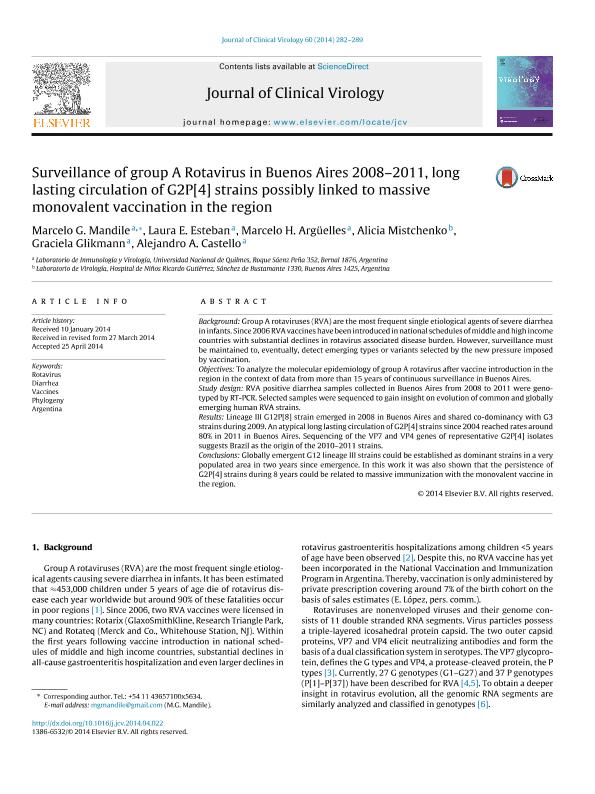Mostrar el registro sencillo del ítem
dc.contributor.author
Mandile, Marcelo Gastón

dc.contributor.author
Esteban, Laura Emilia

dc.contributor.author
Argüelles, Marcelo Horacio

dc.contributor.author
Mistchenko, Alicia Susana

dc.contributor.author
Almallo de Glikmann, Graciela

dc.contributor.author
Castello, Alejandro Andrés

dc.date.available
2018-02-06T20:32:55Z
dc.date.issued
2014-07
dc.identifier.citation
Mandile, Marcelo Gastón; Esteban, Laura Emilia; Argüelles, Marcelo Horacio; Mistchenko, Alicia Susana; Almallo de Glikmann, Graciela; et al.; Surveillance of group A Rotavirus in Buenos Aires 2008-2011, long lasting circulation of G2P[4] strains possibly linked to massive monovalent vaccination in the region.; Elsevier Science; Journal of Clinical Virology; 60; 3; 7-2014; 282-289
dc.identifier.issn
1386-6532
dc.identifier.uri
http://hdl.handle.net/11336/35886
dc.description.abstract
Background: Group A rotaviruses (RVA) are the most frequent single etiological agents of severe diarrhea in infants. Since 2006 RVA vaccines have been introduced in national schedules of middle and high income countries with substantial declines in rotavirus associated disease burden. However, surveillance must be maintained to, eventually, detect emerging types or variants selected by the new pressure imposed by vaccination. Objectives: To analyze the molecular epidemiology of group A rotavirus after vaccine introduction in the region in the context of data from more than 15 years of continuous surveillance in Buenos Aires. Study design: RVA positive diarrhea samples collected in Buenos Aires from 2008 to 2011 were genotyped by RT-PCR. Selected samples were sequenced to gain insight on evolution of common and globally emerging human RVA strains. Results: Lineage III G12P[8] strain emerged in 2008 in Buenos Aires and shared co-dominancy with G3 strains during 2009. An atypical long lasting circulation of G2P[4] strains since 2004 reached rates around 80% in 2011 in Buenos Aires. Sequencing of the VP7 and VP4 genes of representative G2P[4] isolates suggests Brazil as the origin of the 2010?2011 strains. Conclusions: Globally emergent G12 lineage III strains could be established as dominant strains in a very populated area in two years since emergence. In this work it was also shown that the persistence of G2P[4] strains during 8 years could be related to massive immunization with the monovalent vaccine in the region.
dc.format
application/pdf
dc.language.iso
eng
dc.publisher
Elsevier Science

dc.rights
info:eu-repo/semantics/openAccess
dc.rights.uri
https://creativecommons.org/licenses/by-nc-sa/2.5/ar/
dc.subject
Rotavirus
dc.subject
Diarrhea
dc.subject
Vaccines
dc.subject
Phylogeny
dc.subject.classification
Otras Ciencias Biológicas

dc.subject.classification
Ciencias Biológicas

dc.subject.classification
CIENCIAS NATURALES Y EXACTAS

dc.title
Surveillance of group A Rotavirus in Buenos Aires 2008-2011, long lasting circulation of G2P[4] strains possibly linked to massive monovalent vaccination in the region.
dc.type
info:eu-repo/semantics/article
dc.type
info:ar-repo/semantics/artículo
dc.type
info:eu-repo/semantics/publishedVersion
dc.date.updated
2018-02-06T20:08:51Z
dc.journal.volume
60
dc.journal.number
3
dc.journal.pagination
282-289
dc.journal.pais
Países Bajos

dc.journal.ciudad
Amsterdam
dc.description.fil
Fil: Mandile, Marcelo Gastón. Universidad Nacional de Quilmes. Departamento de Ciencia y Tecnología. Laboratorio de Virologia; Argentina. Consejo Nacional de Investigaciones Científicas y Técnicas; Argentina
dc.description.fil
Fil: Esteban, Laura Emilia. Consejo Nacional de Investigaciones Científicas y Técnicas; Argentina. Universidad Nacional de Quilmes. Departamento de Ciencia y Tecnología. Laboratorio de Virologia; Argentina
dc.description.fil
Fil: Argüelles, Marcelo Horacio. Consejo Nacional de Investigaciones Científicas y Técnicas; Argentina. Universidad Nacional de Quilmes. Departamento de Ciencia y Tecnología. Laboratorio de Virologia; Argentina
dc.description.fil
Fil: Mistchenko, Alicia Susana. Gobierno de la Ciudad de Buenos Aires. Hospital General de Niños ; Argentina
dc.description.fil
Fil: Almallo de Glikmann, Graciela. Universidad Nacional de Quilmes. Departamento de Ciencia y Tecnología. Laboratorio de Virologia; Argentina
dc.description.fil
Fil: Castello, Alejandro Andrés. Universidad Nacional de Quilmes. Departamento de Ciencia y Tecnología. Laboratorio de Virologia; Argentina
dc.journal.title
Journal of Clinical Virology

dc.relation.alternativeid
info:eu-repo/semantics/altIdentifier/doi/http://dx.doi.org/10.1016/j.jcv.2014.04.022
Archivos asociados
